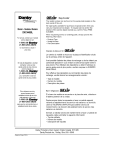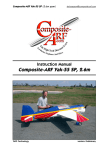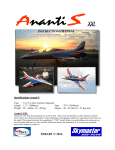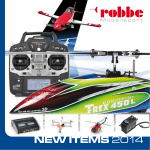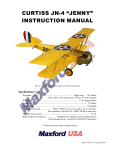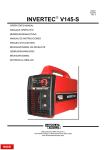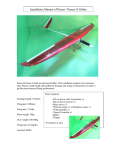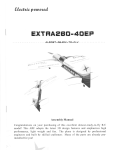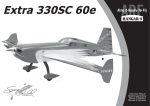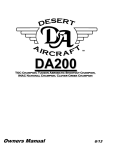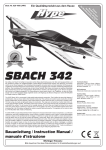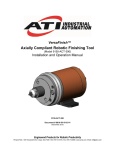Download Manual Extra 330SC - CARF
Transcript
CARF-Models Extra 330SC (3.1m) www.carf-models.com Supplementary Safety Notes Pre-flight checking: Before every session check that all the model’s working systems function correctly, and be sure to carry out a range check. The first time you fly any new model aircraft we strongly recommend that you enlist the help of an experienced modeller to help you check the model and offer advice while you are flying. He should be capable of detecting potential weak points and errors. Be certain to keep to the recommended CG position and control surface travels. If adjustments are required, carry them out before operating the model. Be aware of any instructions and warnings of other manufacturers, whose product(s) you use to fly this particular aircraft, especially engines and radio equipment. Please don’t ignore our warnings, or those provided by other manufacturers. They refer to things and processes which, if ignored, could result in permanent damage or fatal injury. Attention ! This IMAC-Aircraft is a high-end product and can create an enormous risk for both pilot and spectators, if not handled with care, and used according to the instructions. Make sure that you operate your Extra according to the AMA rules, or those laws and regulations governing the model flying in the country of use. The engine, servos and control surfaces have to be attached properly. Please use only the recommended engines, servos, propellers, and the accessories supplied in the kit. Make sure that the ‘Centre of Gravity’ is located in the recommended place. Use the nose heavy end of the CG range for your first flights, before you start moving the CG back to a more critical position for 3D-manoeuvres. If you find that you need to relocate your batteries or even add weight in the aircraft to move the CG to the recommended position, please do so and don’t try to save weight or hassle. A tail heavy plane, in a first flight, can be an enormous danger for you and all spectators. Fix any weights, and heavy items like batteries, very securely to the plane. Make sure that the plane is secured properly when you start up the engine. Have at least 2 helpers hold your plane from the tail end or from behind the wing tips before you start the engine. Make sure that all spectators are behind, or far in front, of the aircraft when running up the engine. Make sure that you range check your R/C system thoroughly before the first flight. It is absolutely necessary to range check your complete R/C installation first WITHOUT the engine running. Leave the transmitter antenna retracted, and check the distance you can walk before ‘fail-safe’ occurs. Then start up the engine, run it at about half throttle and repeat this range check with the engine running. Make sure that there is no range reduction before ‘fail-safe’ occurs. Only then make the 1st flight. If you feel that the range with engine running is less then with the engine off, please contact the radio supplier and the engine manufacturer and DON’T FLY at that time. Make sure that you range check your R/C system thoroughly before the first flight. It is absolutely necessary to range check your complete R/C installation first WITHOUT the engine running. Leave the transmitter antenna retracted, and check the distance you can walk before ‘fail-safe’ occurs. Then start up the engine, run it at about half throttle and repeat this range check with the engine running. Make sure that there is no range reduction before ‘fail-safe’ occurs. Only then make the 1st flight. If you feel that the range with engine running is less then with the engine off, please contact the radio supplier and the engine manufacturer and DON’T FLY at that time. 2 CARF-Models Extra 330SC (3.1m) www.carf-models.com Check for vibrations through the whole throttle range. The engine should run smoothly with no unusual vibration. If you think that there are any excessive vibrations at any engine rpm’s, DON’T FLY at this time and check your engine, spinner and propeller for proper balancing. The lightweight sandwich composite parts don’t like too much vibration and they can suffer damage. The low mass of all the parts results in a low physical inertia, so that any excess vibrations can affect the servos and linkages. Make sure that your main spar tube is not damaged. Check that the anti-rotation pins for the wings and horizontal stabiliser tubes are located correctly in their holes, and are not loose. Check that the 4 plastic wing retaining nuts are tight, that the M3 bolts retaining the horizontal stabilisers onto the aluminium spar tube are installed and tight, and that the hinge tubes for the rudder and elevators cannot come out. If you carefully checked all the points above and followed our advice exactly, you will have a safe and successful first flight - and many hours of pleasure with your CARF Extra. General information about fullycomposite aircraft structure and design All the parts are produced in negative molds, manufactured using vacuum-bagged sandwich construction technology. All parts are painted in the moulds, either single colour or designer colour schemes. A new production method, called TAVS (Total Area Vacuum Sandwich), enables us to present this aircraft with incredible built-in strength, while still being lightweight, and for a price that nobody could even consider a few years ago. This production process has huge advantages, but a few disadvantages as well. These facts need to be explained in advance for your better understanding. Description of Parts The Wings: Both wing halves are made in negative moulds, and fully vacuum bagged, using only 2 layers of 2 oz. cloth in combination with a very hard 2 mm foam sandwich to form a hard and durable outer skin. Because of this TAVS technology very few additional structural parts are needed except for main spars. The wings are already set-up for 2 servos per aileron. They are attached to the fuselage with the 4 threaded aluminium dowel anti-rotation pins, with 4 big plastic nuts inside the fuselage. If the aluminium dowels come loose in the wing, the wing will slide outwards, away from the fuselage, and the main spar tube will definitely break. So take great care to inspect the glue joints of these anti-rotation dowels in the wing REGULARLY. Excessive vibrations or hard shocks can cause the glue joints to weaken or break. Monitor these joints whenever you set up your plane. Never forget to tighten the nuts inside the fuselage. Please DO NOT modify these attachment dowels in any way, their perfect function is proven for many years. 3 CARF-Models Extra 330SC (3.1m) www.carf-models.com The Fuselage: The fuselage is also made in negative moulds, and it is also constructed using TAVS technology, with carbon reinforcement in strategic positions. All the loadbearing internal parts are glued in during manufacture, to ensure accurate location and reduce the assembly time for you. The fibreglass tubes in the wings and fuselage to receive the wing tube spar, the stab spar tube, and the holes and reinforcement plates for the anti-rotation dowels, are already installed. The strong landing gear mount is pre-installed and doesn’t need any extra reinforcement. You have an extremely light weight fuselage, and the gear loads need to be led into the structure gently. No glue joint needs to be stronger than the materials that it is attached to, as it would just result in increased weight for no advantage. The landing gear is a fairly flexible design, which works very much like shock absorbers. This plane is not made for crashing, but the landing gear will take some hard landings without problems. Do not change or modify it, as the results would only be negative. We had plenty of time and experience to engineer the strength needed in this area - and we did! The motordome and firewall are pre-installed, and provide plenty of strength for any engines up to 220cc on the market today. See the Engine Installation section for details of engine and setting thrust angles. The engine cowling should be attached using the method shown. It is only a little work and this mounting system has been tested and proven for many years. The Stabilisers: The stab parts are also vacuum bagged sandwiched. The rudder and elevator control surfaces are hinged with 4mm Ø tubes, fitted through phenolic hinge bearing plates which are installed during manufacture for perfect alignment. All the structural parts are pre-installed. The horizontal stabs are mounted with on a pair of 20mm aluminium alloy tube spars. The rudder & elevator design allows for at least 45 degrees throw. It is mandatory that each stab is fitted with powerful digital servos, and that the counter-balances are partially statically-balanced by adding about 20 gramms (1 ounce) of lead in each. Take Care: Composite sandwich parts are extremely strong, but fragile at the same time. Always keep in mind that these contest airplanes are designed for minimum weight and maximum strength in flight. Please take care of it, especially when it is being transported, to make sure that none of the critical parts and linkages are damaged. Always handle your airplane with great care, especially on the ground and during transport, so you will have many hours of pleasure with it. 4 CARF-Models Extra 330SC (3.1m) www.carf-models.com Tools and Adhesives Tools etc: This is a very quick and easy plane to build, not requiring difficult techniques or special equipment, but even the building of CARF aircraft requires some suitable tools! You will probably have all these tools in your workshop anyway, but if not, they should be available in all good hobby shops, or hardware stores. Sharp knife (X-Acto or similar) Allen key set (metric) 2.5mm, 3mm, 4mm & 5mm Sharp scissors Pliers (various types) Wrenches (metric) Slotted and Phillips screwdrivers (various sizes) M3 tapping tool (metric) Drills of various sizes (metric) Small spirit level, or incidence meter. Dremel tool (or Proxxon, or similar) with cutting discs, sanding tools and mills. Sandpaper (various grits), or Permagrit sanding tools (high quality). Carpet, bubble wrap or soft cloth to cover your work bench (most important !) Car wax polish (clear) Paper masking tape Denaturised alcohol, or similar (for cleaning joints before gluing) Adhesives: Not all types of glues are suited to working with composite parts. Here is a selection of what we normally use, and what we can truly recommend. Please don’t use inferior quality glues - you will end up with an inferior quality plane, that is not so strong or safe. CA-Glue ‘Thin’ and ‘Thick’ types. We recommend ZAP, as this is a very high quality. ZAP-O or PlastiZAP, odourless (for gluing in the clear canopy) 5 minute-epoxy (highest quality seems to be Z-Poxy) 30 minute epoxy (stressed joints must be glued with 30 min and NOT 5 min epoxy). Epoxy laminating resin (12 - 24 hr cure) with hardener. Milled glass fibre, for adding to slow epoxy for strong joints. Microballoons, for adding to slow epoxy for lightweight filling At CARF we try our best to offer you a high quality kit, combined with outstanding valuefor-money, and as complete as possible. However, if you feel that some additional or different hardware should be included, please feel free to let us know. Email us @: [email protected] We know that even good things can be made better ! 5 CARF-Models Extra 330SC (3.1m) www.carf-models.com Accessories Here is a list of the things you may need to get your CARF Extra 330SC into the air. Some of them are mandatory, some of them can be chosen by you. What we list here are highly recommended parts, and have been thoroughly tested. Power servos (min.8 req’d). We recommend JR DS8911 or Futaba BLS172 Throttle servo: This servo is more important than you believe. We advise to install a robust full-metal-gear servo to be sure it doesn’t die anytime during flight. Aluminium Spinner 140 mm dia (5.5”), eg: Tru-Turn or Dave Brown. Main wheels 125 mm (5"). Dubro wheels are recommended. Engine 150 - 220 cc .This manual shows the DA170 on tuned pipes and the DA200 on canisters, which both give awesome performance. Canister Muffler Set. (2 canisters, 2 aluminium headers, 2 Teflon couplers, 4 spring clamps - complete sets available from CARF as an option) or tuned pipes Receiver batteries. 2 x 2700 - 4000 mAH LiPos are recommended Ignition switch and battery for motor. 4 cell 1400 - 2400 mA or LiPo (with voltage regulation) recommended. Powerbox Competition and dual power switches for Rx batteries. Fuel tank (1500 ml) with gasoline stopper. We used a Dubro S-50 or PET-bottles. Propeller. Carbon 30 x 13 or 30 x 12 Meijzlik or Menz for 170 cc motor, 31x13 or 32x11 for 200cc or similar. General information We will update these instructions as needed, and they will be freely downloadable from the website. Please check on our website that you have the latest version before assembling your Extra . Did you read the warnings above, and understand the instructions completely? Then, and only then, let’s start assembling your CARF Extra 330SC. If not, please read again before you start the assembly... Building Instructions Note: The general assembly of the Extra 330SC 3.1m is very similar to our SuperXtra, ‘Extra 260’ and Yak 55SP, so a few of the photos in this manual actually show the 260 or SuperXtra - where the construction and assembly are identical. You can easily see when we have used photos from other aircraft, because of the difference in colour schemes - so please don’t get confused ! 6 CARF-Models Extra 330SC (3.1m) www.carf-models.com General Tips: We recommend that you follow the general order of construction shown in this manual for the fuselage, as it makes access to everything easier and saves time in the end. The last item to be glued in position should be the Fuel tank mounting plate, as it makes access to the rudder tray and exhaust system less easy. The wings and stabs can be done at almost any time, and only need servos installing anyway, as the control-surface horns are factory-installed for you. The first thing to do is protect the finished paint on the outside of the model from scratches and dents during building - so cover your work table with a piece of soft carpet, cloth or bubble-plastic. The best way to stop small spots of glue getting stuck to the outside of the fuselage is to give the whole model 2 good coats of clear car wax first, but of course you must be sure to remove this 100% properly before adding any additional decals or markings. If you prefer you can cover the majority of the fuselage with the bubble-plastic used to pack your model for shipping, fixed with paper masking tape, which also protects it very well. When sanding any areas of the inside of the fuselage to prepare the surface for gluing something onto it, do NOT sand right through the layer of glasscloth on the inside foam sandwich ! It is only necessary to rough up the surface, with 60/80 grit or equivalent, and wipe off any dust with alcohol (or similar) before gluing to make a perfect joint. Before starting construction it is a good idea to check inside the fuselage for any loose glass fibres that could cut your hands, and a quick scuff over any of these with a coarse Scotchbrite pad will remove them. Note: It is very important to prepare the inside of all composite parts properly, by sanding and cleaning the surface with de-natured alcohol or equivalent, before gluing any parts to them. 7 CARF-Models Extra 330SC (3.1m) www.carf-models.com Landing Gear The 1st job is to fit the landing gear legs (wheel pants and cuffs can be done later) - and you can leave these in place to protect the bottom of the fuselage during assembly. The CARF landing gear for the Extra consists of 45 deg laminated carbon fibre cloth and a huge number of carbon rovings inside, all made under vacuum and heat cured. However it is still light weight, and retains enough flexibility to take the shock out of any landings that are lessthan-perfect! The moulded dimple in the bottom of the carbon legs. Drill a central hole of 6mm diameter. Drill out the molded dimples in the carbon legs to a hole of 6mm dia. Both main legs are identical, and can be used either side. The carbon landing gear legs are secured to the revised aircraft-grade plywood supports and bulkheads in the fuselage (factory-installed), using the supplied M6 x 20mm bolts and washers into the pre-installed T-nuts. The wheelpants have a moulded-in recess for the end of the landing gear legs. Drill an 8mm Ø hole through the mouldedin ‘dimple’ for the axle, and another 8mm hole directly opposite, on the outside surface of the wheelpant for inserting the axle bolt. Prepare the inner surface of the wheelpants. Take the 2 milled plywood ‘U’ shaped pieces and enlarge the 6mm Ø holes to 8mm diameter. Press the M6 T-nuts into the holes, just far enough so that the end of the T-nut projects through the hole a maximum of 1mm. The ‘spikes’ still engage in the plywood, and the gap between the T-nut and the plywood is filled with epoxy and microballoons mixture later. Glue the 2 ‘U’ shaped milled plywood pieces to the inside surface of the wheelpants with 30 minute epoxy and microballoons mixture, over the kevlar reinforcement, in line with the moulded recess, and so that the hole in the plywood is exactly lined up with the 8mm hole you have drilled in the wheelpant. Temporarily use the axle bolts and nuts to secure while the glue dries. At the same time secure the T-nut to the plywood with some of the thick epoxy/micro mixture, as shown in the photo. Drill 6mm Ø through the centre of the moulded dimples in the bottom of the carbon legs (photo above), and bolt to the wheelpants temporarily with the axle bolt. Drill a 3mm hole thru’ the carbon leg and wheelpant, approx. 25mm above the axle. Fit an M3 bolt and washer, and use an M3 T-nut inside - also secured to the plywood ‘U’ shape with epoxy/micro mixture. This bolt sets the precise angle of the wheelpant to the carbon landing gear leg. Do not use a bolt of larger diameter, as the larger hole required could weaken the leg. Install your chosen wheels (eg: Dubro 5”), inserting the M6 x 70mm hardened steel axle bolt through the hole you drilled 8 The wheepants Our titan tailwheel is an optional part available from CARF. Connect the steering arm to the rudder horns with springs for steering option if required. CARF-Models Extra 330SC (3.1m) in the outside surface of the wheelpant. Depending on the thickness of your chosen wheel, you will need 1 or 2 of the M6 washers either side of the wheel to centre it - and also an M6 wheel collar (supplied) on both sides as well, between the washers and the ‘T’ nut. Tighten the axle bolt securely into the T-nut, and then secure the assembled wheelpant to the carbon leg using an M6 washer and M6 locknut as shown. A drop of loctite on the M6 lock-nut is good insurance. Leg Cuffs The Extra 330SC has fairings at the top of each LG leg where they enter the fuselage, and these are supplied in the kit as lightweight fibreglass mouldings. We suggest that they are glued in place onto the LG with silicone adhesive (bath sealant), so they can easily be removed if necessary. Note that there is a ‘right’ and a ‘left’ leg cuff, but which is which will be very obvious when you trial fit them to the fuselage! Mill the slot in each cuff for the carbon legs. Sand border of the cuffs smooth, and glue to LG with a little clear silicone adhesive. www.carf-models.com Our carbon tailwheel installed under the fuselage with two M4x20mm Screws. The leg cuffs glued in place onto the LG with silicone. Tailwheel The tail wheel setup shown on these photos is an optional part available from C-ARF, and is mounted with two M4x20 mm allen bolts under the fuselage, screwed into two M4 Tnuts in the factory installed plywood reinforcement. You don’t need to make the tailwheel steerable if flying from grass surfaces, a simple castoring action is fine. However, for hard runways you may prefer to connect it either to the rudder horn with 2 springs as shown, or even better to the rudder pull-pull cables. It’s easy to make the springs by winding some 0.8mm Ø piano wire around a 5mm drill bit, turned slowly in a battery-drill, with a small hook in each end to connect to the tailwheel steering arms. Remember - keep it lightweight at the tail end! The cowl position firmly taped in Cowling Attaching the 2 piece cowling is quite easy, as it is already cut and trimmed at the factory, and should need almost no adjustment for a perfect fit. If necessary you can sand the inside back edges of both halves of the cowling to have a perfect flush fit with the fuselage. The top and bottom cowling halves are joined together with eight M3 x 12mm allen bolts, don't forget the outside edges of the circular cutout at the front. The back edge of the lower 9 The spinner fits perfectly to the front of the cowling CARF-Models Extra 330SC (3.1m) www.carf-models.com cowling is secured to the fuselage with three M3 bolts each side, and the upper half secured with another three M3 bolts. All these bolts go into M3 T-nuts, which are glued to the inside of the cowling or fuselage, in reverse - that is with the ‘spikes’ pointing inwards. All bolt heads should have M3 washers under them, and these are included in the hardware. Tape the cowl firmly in position, and drill the holes with a sharp 3 mm drill, on the fuselage sides about 7mm from the back edge of the cowl and on each horizontal side about 6 mm above the edges of the upper halve. Sand around each hole, and clean off the dust. Insert the bolts, check position, screw on the ‘T-nuts’ and secure each with a drop of thick CA. Finally secure all the M3 T-nuts with a drop of thick epoxy/microballoon mixture over the ‘spikes’ With the clear canopy tacked into place with the frame on the fuselage, carefully remove it & complete the gluing on a flat table. Cockpit Canopy The canopy frame mounting has already been completed at the factory for you. It is held in place with 4 bolts (M4 x 12mm) into T-nuts inside in the plywood tongues, and the holes are already counter-bored so that the bolt-heads sit almost flush with the fuselage surface. Sand the inside edges of the canopy frame carefully with rough sandpaper, especially the joining tape inside the seams, to ensure a perfect fit of the canopy inside. Lay the canopy on top of the frame, and mark the rough shape with a felt pen or wax crayon. Cut the outer border of the clear canopy with sharp scissors, about 12mm (1/2”) too big all around. Unless you are in a very warm room, we recommend that the canopy is slightly warmed up with a hair dryer to prevent cracking - but be careful not to melt or deform it! When the canopy fits inside the frame roughly, mark the final cut line on it. Then cut it to exact shape with a 6 - 8 mm overlap all around. TIP: The rear sides of the Extra canopy frame are exactly straight, and it helps to temporarily fix a strip of 3mm thick x 12mm high plywood on both sides of the frame while gluing the canopy in position to prevent you deforming it. Just apply some strips of paper masking tape to the sides of the canopy frame, and CA the plywood strips to them temporarily while gluing the clear canopy in place, and then remove afterwards. Make many hand-holds with wide duct-tape to make holding and positioning the canopy easier. With the canopy frame on a flat table, push the canopy up tightly inside the back of the frame and fix the just bottom 2 back corners with one very 10 Secure all around the inside edges with epoxy and microballoons mixture, as seen on this Extra 260. Pilot-doll at the cockpit. Always an eye-catcher. CARF-Models Extra 330SC (3.1m) www.carf-models.com small drop of slow CA each (ZAP-O or Plasti-ZAP recommended). Note: Do NOT use any CA accelerator/kicker - you will immediately ‘fog’ the clear canopy! Temporarily tape the front and sides of the clear canopy to the inside the frame, in as many positions as possible. Mount the canopy frame to the fuselage (use all 4 bolts), and tape the back and front of the canopy frame tightly to the fuselage, closing any small gaps that may be there. Then make visual check from the front and back to make sure sure that the canopy is straight. Using the duct-tape handles to pull the canopy outwards firmly against the frame, working from the back towards the front, glue the edges of the canopy in place in 2 or 3 more places each side, with just a single very small drop of CA at each position, all the time checking that the edge of the canopy is tight up against the frame at the front. It really helps to have 4 hands for this job, so get another person to help you ! Now that the canopy is fixed in position and cannot twist or warp anymore, you can carefully glue the rest of the canopy firmly in place. You can either complete the gluing from the outside (with the frame still mounted on the fuselage), allowing the odorless CA glue to wick into the joint between the frame and the clear plastic or, if you prefer, you can carefully remove the canopy frame from the fuselage, and use a 30 minute or 24hr epoxy and micro-balloon mixture for gluing all the edges to the frame on the inside surface. Rear stab spar tube has M3 Tnuts installed at the factory for the securing bolts. We recommend to use fullmetal servo arms such as the ones of SWB (above) or Secraft (below) We highly recommend that you glue all around the inside edges of the clear canopy with the epoxy & micro-balloon mixture to be sure that the clear canopy cannot come off in flight. If you wish you can tint the inside of the canopy using one of the aerosol spray paints used for painting the inside of polycarbonate car bodies (eg: the Tamiya or Lexanit ranges). Use many very light coats to get even coverage. Horizontal Stabs The stabs are 100% finished at the factory, and only need the servos and linkages installing. Insert the 20mm aluminium tube spar in the fuselage sleeve, and slide on both stabs to check the fit between the root ribs and the fuselage. The elevators are hinged to each stab using the 4mm Ø brass tubes provided. Make sure there is no burr on either end of the tubes, and chamfer the ends slightly with fine sandpaper to make it easier to get them through the holes in the phenolic hinge plates. Be careful inserting them, and if they are a bit stiff, then use a little grease on the tubes. Don’t 11 A plug at the fuselage connects the elevator servos to the RCSystem CARF-Models Extra 330SC (3.1m) www.carf-models.com use too much force, otherwise a phenolic hinge post inside might break loose. Alternatively you can use 4mm carbon tubes which definitively will have to be greased. You have a choice of elevator servos. Anyway you should use only hi-power digital servos with more than 280Ncm torque. We recommend JR DS8911 or Futaba BLS152 or BLS172 which fit perfectly in the milled servo cutouts and supply enough power for extreme maneouvers. To obtain sufficient elevator throws, quite long servo output arms are needed (about 50mm). We advise to use full metal servo arms, for example SWB or Secraft. These arms clamp onto the servo output shaft with no lost movement (slop) at all. These are high quality, properly engineered arms, and are available from many good hobby stores. Anyway you must not use any plastic servo arms or output discs with extensions. The extreme torque of the current hi-torque digital servos can strip the plastic splines - which will result in immediate flutter and destruction of your Extra. Linkage with a ball-link on each side Install the servos by using the 2.9mm Ø x 13mm sheetmetal screws provided in the kit. Centre both elevator servos using your R/C and mount the servo arms, making sure that the arms are both at 90° to the bottom surface of the stabs. Do not forget to add a drop of Loctite to the bolt that secures the arms to the servos. Make sure that your servo arm slots allow enough space for maximum throw. Otherwise extend them using a cutter. The linkages between the servo arms and elevator horns are made from the 75mm x M3 all-thread with a ball-link on the control horns. You can fit a single-sided ball-link onto the aluminium servo arm. Alternatively you can also use clevises with aluminium pins in aluminum servo arms. We highly recommend that you apply a little grease on these joints to give smooth movement and prevent any inclination of the aluminium pin to bind in the servo arm hole. Secure the clevises by a M3 nut provided in the kit. Linkage with a ball-link on the control horns and a clevise in the aluminium servo arm. It is important that the linkage is exactly in-line with the phenolic control surface horns in the elevators, as any ‘sideload’ or ‘twisting’ could weaken or even break them, causing flutter and destruction of your Extra. The last step to finish your stabs is to partially static-balance the elevators by gluing 20 grams of lead inside the massbalance area in each elevator half, which helps to prevent any chance of flutter that could destroy your Extra. Rudder The rudder is 100% completed, with the phenolic hinge posts and the dual phenolic rudder horns already glued in place at 12 Glue 20 grams of lead inside the mass-balance area in order to static-balance the elevators CARF-Models Extra 330SC (3.1m) www.carf-models.com the factory during manufacture. Hinge the rudder to the vertical stabilizer with the 4mm Ø brass tube supplied, in the same way as the elevators. Check for smooth movement. You can solder an M4 metal washer onto one end of the tube, and then secure this with a small piece of clear tape for flight. The rudder is a big surface on the Extra. If you want to install only two servos, we highly recommend to use JR DS8911 or Futaba BLS152 or BLS172. Both servo types can be fitted in our CNC milled rudder tray, so the choice is up to you. Make up the rudder tray from the milled parts. Prepare all joints by sanding, and assemble as shown, using thin CA to secure all the tabs and slots. Cut 4 small pieces of plywood (30mm x 12mm) and epoxy onto the bottom of all the servo rails. Finally reinforce all joints with epoxy and micro-balloons mixture. Drill the 2mm Ø holes for the 2.9mmØ servo mounting screws before gluing the assembly into the fuselage - it’s much easier! Position of the rudder tray when installing DA200 Prepare the inside surface of the fuselage carefully with sanding and clean off with de-natured alcohol (or equiv.), and glue the complete rudder tray assembly in place with epoxy and microballoons mixture, with a nice fillet on all joints. Install the servos into the rudder tray using the 2.9mm Ø x 13mm screws supplied, with the servo output shafts towards the tail of the plane. We recommend to use full metal servo arms (SWB or Secraft). With the R/C switched ‘ON’ place the rudder servo horns and align so that they are at 90° to the rudder servo tray. Now connect the horns together with the 45mm long M3 allthread, two ball-links or alternatively one aluminium clevise (q.v. Stabs), M3 bolts and locknuts provided. Adjust them so that there is no servo ‘buzzing’ at neutral or full throw. It's absolutely important that the two servo arms are as parallel as possible. Any divergence will cause tensions increasing current draw unnecessarily. You will need to cut 40mm long slots for the cable exits. Mark the slots on a piece of masking tape stuck to the fuselage, and cut them out a bit too small to begin with, using a very sharp knife, and then adjust with a small file - all the time checking the alignment with the rudder cables. As only small slots are needed, it's recommendable to cross the cables. If your servo arm is smaller than the rudder control horn, rudder will have a bit backlash at maximum throw. Don't worry about that. At maximum throw there is always force on the rudder during flight by which flutter is prevented. 13 Position of the rudder tray when installing DA170 on tuned pipes Some measure to start with CARF-Models Extra 330SC (3.1m) Make up the pull-pull wires for the rudder from the hardware supplied, with a loop at the front that goes over the hooks on the output arms, and a ball-link with turnbuckle/threaded end and locknut at the rudder end (if using full metal arms, install a ball-link at the front as well). For security pass the closed loop cable through the supplied ‘crimping tubes’ 2 times before squashing flat with pliers. If you like you can add a small sleeve of heat shrink tubing over this connection to make sure that it cannot ‘snag’ when the cable is slack. Make sure that the wires are tight, and check & adjust after the first few flights if necessary. Even a small amount of slop at neutral position will prevent your Extra from perfect tracking. www.carf-models.com Make sure that the servo arms are parallel Wings The wings are 100% finished at the factory, and have already been installed on your fuselage to check the alignment. The dual phenolic aileron control surface horns have been installed for you. The 4 plastic nuts screw onto the M6 threaded aluminium wing dowels to retain the wings to the fuselage. The ailerons are big surfaces on the Extra. We recommend to use two JR DS8911 or Futaba BLS152 or BLS172 servos on each wing, which provide enough power for all manouvers. Note that a too small holding torque of your servos can cause fluttering. The first job is to install the outer Servo. For that purpose cut a servo hatch in the bottom of the wing surface as shown on the photos. You will need to re-use the section of wing that you cut out for the hatch cover, so be careful cutting it out. Reinforce the underside of the wing skin with two plywood stripes. After installing the servo secure the hatch using four 2.3 Ø x 10mm sheetmetal screws in each. Now the servo cable has to be extended to a length of 850mm. Lay the cable through the provided holes and install the servo using the 2.9mm Ø x 13mm screws supplied. Therefor you need a very long X-head screwdriver and insert it from the wing root. If the mounting holes of your servos are too small for our 2.9mm Ø x 13mm screws, you have to use at least 2mm Ø screws. After extending the cable of the inner servo to a length of 530mm you can install it as well. Installing procedure is analog to the outer servo. We advise to use full metal servo arms (SWB or Secraft). Assembly as well as setting up the linkage is just the same as on stabs or rudder using the 85mm long M3 all-thread for the outer and inner servo. If you want to, you can fix the 4mm tube with a M4 grub screw to the rudder The outer servo of the wing and the long X-head screw driver The servo hatch in the bottom of the wing 14 CARF-Models Extra 330SC (3.1m) www.carf-models.com Engine and Exhaust Installation Here we show the installation of a Desert Aircraft DA-200 on KS canisters and DA-170 on KS tuned pipes which both are combinations with lots of power, and a very good throttle response throughout the whole range. Both motors fit fully enclosed in the cowling, and no cutouts or holes are needed. Of course many other engines in the 150-200 cc range are suitable as well. All measurements shown here are according to this setups. The integrally-moulded motor dome is reinforced inside with plenty of carbonfibre during manufacture and does not require any additional strengthening, and the plywood reinforcement plate on the inside surface is already installed for you. You don't have to worry about right-thrust or down/upthrust, as long as you follow the already predefined front of your cowling. Only make sure that the spinner alignes perfectly. The fuselage in vertical position at the hallway To set the positions for the 4 mounting holes for the DA-200, first accurately mark a vertical centreline on the front of the plywood firewall, in line with the joint seam of the fuselage. Then set-out dimensions for the DA200 mounting as shown on the photo. The positions should be controlled definitively before drilling the holes. For that purpose you can use the plywood reinforcement plate supplied in the kit. Now you need four screws with two nuts on each to adjust right- and upthrust. Assemble it as shown on the photos (reference values for the distances can be found on the sketch). Put the fuselage in vertical position and place the engine, preassembled with the plywood reinforcement plate, on the motor dome. After you have checked the dimensions drill the holes and glue the plywood reinforcement plate in place. Don't forget to note the dimensions of the distances so that they can be easily replaced by the pack of washers. If you decided to use any other engine and need to set different positions for the 4 mounting holes, the easiest way to achieve perfect fit of it will be to place the engine in a vertical position of the fuselage with the bottom cowling mounted (for example at the hallway). So, the engine can be adjusted easily to the motor dome till the spinner fits perfectly to the cowling. This procedure also will be necessary if you want to install any 2-cyl twin engine (e.g. DA170) so that the adapting kit supplied in the kit is needed. First build up the plywood cuboid which will give your motor dome the right stability. Put all plywood plates together as shown on the photo using some epoxy and micro-balloon mixture. 15 Some measure for DA200 The four screws with two nuts on each to adjust right- and down/upthrust. CARF-Models Extra 330SC (3.1m) www.carf-models.com Then adjust the black extension together with the plywood cuboid and your engine on the motor dome as described before. You won’t need any washers – right- and down/upthrust have to be adjusted by the position of the motor dome extension. Now you need a long 6mm borer and drill perpendicular to the front plane of the black covering through all. The last job is to glue the adapting kit in place with epoxy and microballons mixture and to install the engine by using the M6x100 screws and T-nuts supplied in the kit. It's a must to bolt the engine to the backplate of the motor dome in the fuselage in order to achieve the required stability. The DA200 on KS canisters The plywood cuboid together with the carbon fibre extension The DA170 on KS tuned pipes The DA200 with ignition and the cooling CNC milled distances. Alternatively you can use a pack of washers. Top right 18mm Top left 24mm Bottom right 21mm Bottom left 27mm The DA170 with ignition and the cooling. Don’t forget to secure the connector from the motor pick-up to the ignition unit by a cable tie or some heat shrink tube. 16 CARF-Models Extra 330SC (3.1m) www.carf-models.com Ignition It’s important that your ignition isn’t installed too close to the RC-Systems or the hot engine – try to keep it cool. We suggest to installing it as shown on the photos before. Use some foam rubber for shock absorption. When installing a DA170 or some other boxer engine on tuned pipes we recommend to install the ignition battery at the front of the fuselage. Always try to keep it lightweight at the tail. Otherwise you may need some lead at the front to set the CG to the right position. The ignition and the smoke pump mounted at the dome If you decided to install a 4zyl engine such as the DA200 you won’t have to care about that. Install the ignition battery near to the canopy. So, you can change it easily. Throttle Servo Make up the throttle servo mount from the milled plywood parts supplied, assembled with thin CA, and then glued firmly with 30 minute epoxy and milled-fibre mix. If you use a high-power servo with full-metal gear, it’ll be ok to install it at the dome. But make sure that there is enough cooling! You can glue the servo tray to the motor dome extension. The ignition battery and the throttle servo installed at the dome (DA170) When installing a 4zyl engine we advice to install the throttle servo near to the fuel tank at fuselage not too close to the mufflers. Set up the linkage out of a 4mm carbon tube with a M3 all-thread on each side. Don’t forget to install a small check rail at the backplate of the motor dome (photos below). The KS-ComfortMount mounting-system together with the two aluminium profiles Throttle servo installed at the fuel tank base (DA200) Carbon linkage with a aluminium check rail at the backplate of the motor dome (DA200) The carbon linkage and the short check rail (DA200) 17 The canisters installed at the fuselage CARF-Models Extra 330SC (3.1m) www.carf-models.com Canisters You have a choice of canisters. We use the ones of MTW or Krumscheid KS. To fit the canisters at the fuselage we used the KSComfortMount mounting-system together with two aluminium profiles as shown at the photos. It’s very important to install the mounting rings at the strengthened part of the canisters. That may happen to your canisters, if you don’t reinforce the bearing position Alternatively you can use milled plywood bulkheads with hard silicon tube to isolate the canisters. If the position of the bulkheads is outside the strengthened part, it’s advisable to reinforce the canisters at the particular position with some carbon fiber. Otherwise the canisters may get damaged by the vibrations. Tuned pipes A 170cc engine on tuned pipes is a really great drive for our Extra SC because power is then comparable to a 200cc 4zyl engine. The tuned pipes installed at the fuselage Fitting the pipes at the fuselage is almost the same as fitting the canisters as described before. Note that you’ll need more weight at the front of the fuselage, if tuned pipes are installed. Consider that during the RC-installation. Lay the cables carefully so that there is no chance for any cable to contact the hot pipes. That will kill the isolation and may end in the damage of a servo or your Extra! The cutouts at the bottom of the fuselage for the exhausts should always be reinforced by some carbon roving or the like. The exhausts made of VA tubes and the reinforced cutouts Cooling Whatever type of exhaust system you chose, it is very important to have enough cooling for both the engine and exhaust, and make sure that the warm air can exit the fuselage. We highly recommend that you cut large enough holes in the front of the motor dome so that the canisters and headers can be installed from the front, rather than having to squeeze them under the tank base, or remove the fuel tank for access. This also makes sure that plenty of cooling air can enter and flow around the headers and canisters. Leave at least a 30mm wide strip of fibreglass in between the cutouts, as this area has the carbon joining tape on the inside of the motor dome. 18 The holes in the front of the motor dome CARF-Models Extra 330SC (3.1m) www.carf-models.com You will also need to make a rectangular cutout in the lower back edge of the cowling, as shown at the photos. Radius the corners of all the slots and cut-outs to reduce any chance of tearing of the composite skin. Furthermore we advice to make some cutouts in the bottom cowling for fresh airflow to the canisters or tuned pipes. It is also just as important to make sure that all the warm air can exit the fuselage. You need to cut two slots in the bottom of the fuselage, about 100mm behind the wing tube, each of about 200mm long and 50mm wide. Best is to build up a little scoop in front of the slots as shown at the photos in order to increase airflow. Don’t forget to reinforce the slots by some carbon roving. The canister exhausts and the cutouts in the cowling (DA200) Hood in front of the slots Hoods towards in- and outside Depending on your motor, you will almost certainly need to make a simple 3mm thick balsa baffle plate inside the cowling to make sure that enough cooling air is directed through the engine cylinder fins, instead of just going directly out of the opening in the bottom of the cowling. See the photos for an example, which improves the cooling considerably, and is strongly recommended. A full-size template for this baffle is included at the end of these instructions. In any case, check that your motor is not overheating when you make the “engine-running” R/C range checks before flying. The cutouts in the cowling (DA170 on tuned pipes) The baffle plate inside the cowling (DA170) It’s important that the baffle plate for DA200 encloses the whole engine as you can see above. It consists of three parts which are fitted by M3 screws. 19 The aluminium profile to fit the side parts of the baffle plate for DA200 CARF-Models Extra 330SC (3.1m) www.carf-models.com Fuel Tank installation The Fuel tank base is supplied as 9 cnc milled parts, from 3mm carbon-balsa composite material (see photo right). Assembly is self-explanatory as all parts have interlocking tabs & slots. The 2 longer pieces are glued on the bottom as support rails across the fuselage. Assemble with thin CA, in the same manner as the Rudder tray, and then secure with a good fillet of epoxy and microballoons. Please remember to sand and clean all the mating surfaces for good glue adhesion. The fuel tank base prepared for PET-tanks together with the four mounts There are some different alternatives to fit the fuel tank at the base depending on your fuel tank system and whether you install a smoker or not. We show you two different ways to fit the tank. But at first the tank base has to be fitted to the fuselage. For that purpose the four mounts provided in the kit must be glued in place. Assemble the mounts as shown at the photo right and install a M4 T-nut in each one in order to screw the mounts to the tank base. Then adapt the mounts to their position at the fuselage above the wing tube, prepare the inside surface carefully with sanding and clean off and glue the mounts in place with epoxy and microballons mixture. Now you have to decide which tank system you want to use. 1.5l Dubro-tank Four parts are glued on the top, to make a bay for the tank to sit inside, secured with cable ties in the milled slots. One of the assembled mounts 2x 1.5l PET-bottles (in Germany available is “Hohes C”) for smoke and gasoline Two carbon half-shells are glued to the tank base as shown at the photos. The PET-bottles are fitted to the half-shells with cable ties. Needed templates can be found at the end of the manual. 20 One of the adapted mounts glued in place with epoxy and microballons mixture CARF-Models Extra 330SC (3.1m) www.carf-models.com We use the excellent ‘Tygon’ brand of fuel tubing for all our models. It is totally gasoline and kerosene-proof, and does not go hard and crack with age. Secure the feed tube inside the tank to the clunk with a small cable tie. If the tube is even a little loose on the brass tubes though the stopper, you can be sure it will come off at just the wrong moment and your engine will quit! Therefore please solder small rings or short lengths of larger brass tube onto the brass tubing (easily made from the soft wire of a paperclip wrapped around a small screwdriver) and also secure with a fuel-line clamp or cable-tie (see photo). Don’t miss this small detail - it could cost you your plane! We use the normal 3 tube plumbing system, one from the clunk to feed the motor, one out of the bottom of the plane (vent/overflow) and one at the top for filling (close for flight). If you install a 4zyl engine with two carburetors, it’ll be recommendable to install two clunks. You have the choice to install two fuel tanks (one for each carburetor) or two clunks in one fuel tank. So, the two carburetors won’t influence each other! Drill a hole in the motor firewall where necessary for the fuel feed tube from the tank, and protect it where it passes through the hole using a rubber grommet. Fix the tubing securely to the underside of the top of the motor dome with a couple of cable-ties or equivalent, to make sure that it cannot touch the hot exhaust. 21 The two clunks in one tank extended with a long brass tube to make sure that the clunks aren’t able to fall to the front of the fuel tank. CARF-Models Extra 330SC (3.1m) www.carf-models.com Sm oke System If you want to use a smoke system, the smoke tank can be fitted as shown below. Follow the manufacturer’s instructions for fitting the smoke system. The smoke pump mounted to the fuel tank base The smoke pump mounted to the motor dome RC-installation Everyone has their own favourite methods when fitting the R/C and gear, but the installation shown here can be used as a guide, and similar set-ups have worked perfectly and very reliably in all of our planes flown by C-ARF factory staff, and many of our customers. The rubber grommets to protect the tubes CARF highly recommend that you install a dual receiver battery system, with a high-quality servo powerbus unit and dual switches as shown, for the ultimate in safety and security. The full ‘PowerBox’ range is all available from CARF as an option. Visit our website for more details. We recommend 2 Rx batteries of 2-cells LiPo of between 2800 - 4000mA each. If you have built the Extra using the DA200 and the internal canister set-up shown should find that with all 3 batteries positioned as shown (at the end of the canopy) the C of G will be spot-on, with no lead needed. At our Extra with DA170 on tunes pipes we installed the two receiver batteries just in front of the canopy and the ignition batterie at the motor dome. We used three 2800mAh PowerBox LiPos, two for the receivers in combination with a PowerBox Competition and one for the motor ignition using the PowerBox SparkSwitch. You should always try to place all your RC-components such as receiver, batteries and the powerbus unit close to each other in order to hold the length of the cables to a minimum. For the two different setups (DA200 on canisters or DA170 on tuned pipes) shown in these instructions you can install 22 RC-installation for DA200. If you intend to fly more pattern, you can install the ignition battery a bit closer to the front. CARF-Models Extra 330SC (3.1m) www.carf-models.com all the components as shown at the photos. If you do it like that, you won’t need any lead to obtain the correct CG. It’s recommended to install all of the wiring to the inner skin of the fuselage. And: Keep in mind that 2.4GHz and Carbon is always critical… The easiest way to fit the PowerBox and its battery mounts is to screw each part to three 3mm plywood plates of 25mm diameter. Glue them in place at the fuselage using some thin CA. The PowerBox SparkSwitch for ignition (the second one, next to the powerbus unit, is needed to fire the smokes at the wing ends) RC-installation for DA170 on KS tuned pipes Servo extension leads etc. Please make sure that you use good quality 3-core twistedcable extension leads, of heavy gauge wire with gold-contact connectors, to all the servos. No ‘Y’ leads are needed, as the powerbox provides 2 or more inputs for each channel. At CARF we hard-wire all our servos with twisted cable leads of the exact length required and Multiplex 6-pin connectors, so you can use 1 pin for each wire. We glue the female connectors into small plywood plates in the sides of the fuselage for connecting the stabs and ailerons when assembling the plane. Making up the proper extension cables and connectors is only a little work, if you are proficient with a small solderingiron, and makes assembly of the model at the airfield very 23 We use these 6-pin Multiplex connectors for all the removable connections between wings and fuselage. CARF-Models Extra 330SC (3.1m) www.carf-models.com quick and easy! Once all wires are soldered to the goldplated pins, fit a short length of heatshrink tube over each one. Finally protect all the connections from vibrations etc with a nice blob of glue from a hot-glue gun. Job done. Important Note: Make absolutely sure that all wires and tubes are protected where they pass through, or near to, sharp carbon or fibreglass edges. With the vibration from the engine in flight the composite materials can cut through these critical items in less then 1 flight - which will cost you your plane. You must also make sure that no important services (wires or fuel tubes) can touch hot items, such as the exhaust canisters. If you chose to fit full-length tuned pipes then good ‘wire management’ is even more important and you should secure all wires as far away from the pipes as possible. We advise you to protect all these items with plastic ‘spiral-wrap’ (or equivalent), and make sure that all wires and tubes are firmly fixed to the sides of the fuselage with cable-ties or similar. It is very important to protect all tubes & wires where they pass thru’ fiberglass or carbon parts, or near to composite milled parts, where they could be damaged due to vibrations. Use grommets or split silicone tube around the edges of holes in composite material, and plastic spiral-wrap. Final check Now check that you have fixed all components securely. Keep in mind that all the components inside the aircraft are loaded with the same G’s as the wing and the wing spar during aerobatic manoeuvres. Check engine, cowling, wing and stab mounts carefully again. Are all extension leads, cables and fuel tubes securely fixed to the side of the fuselage and cannot come loose when subjected to high ‘G’ forces during flight. Are all tubes and wires protected from chafing where they pass thru’ the holes in fibreglass parts or bulkheads with rubber grommets, or short lengths of split silicone tubing? Make sure that no fuel tubing or wires can come into contact the exhausts or manifolds. Use the plastic spiral-wrap to tidy up groups of cables and make sure that they cannot move around in the plane under high ’G’ manoeuvres by fixing them to the sides with small cable ties. If using the easilyavailable cable-tie plastic fixing plates, please do not trust the double-sided tape that they usually have on them which can fail under vibrations. Peel it off, rough up the back face with coarse sandpaper and glue them to the fuselage sides with 30minute epoxy. Did you fit small Tygon or silicone tube pieces over all the steel quick-links? Did you tighten the M3 locknuts against all the balllinks and clevises? Are the swages crimped up nice and tight on the rudder cables? 24 Nice shot of our 3.1m Extra SC together with our 2.3m Extra SC CARF-Models Extra 330SC (3.1m) www.carf-models.com Add one small drop of loctite/thread locking compound on all the bolts that hold the servo arms to the servos, especially important with digital types, as the occasional ‘buzzing’ you hear is actually highfrequency vibration which, over some time, can cause the servo arm securing bolts to work loose. We have seen this happen several times - so you can treat it as a fact ! Then you can go on set up all the linkages, control throws and R/C system as described below. The Extra with a nice customscheme Setting up your aircraft Centre of G ravity Set the Centre of Gravity to 100-120mm back from the leading edge at the wing tips. Hold it with a helper at both wing tips in this position and make sure the plane balances horizontally. Balance the plane laterally also, holding the motor propeller shaft and a fingertip under the finpost, and if needed add a small weight to the light wing tip to make it track correctly. Throws Elevator All controls should be set with a dual rate switch. On high rate the elevator should really be at maximum, up to 50 degrees both sides. We added only 15% exponential to the high rate setting in order to provide enough sensitivity during 3D maneuvers. Low rate should be no more than 20 degrees both sides. This is the perfect throw for nice and crisp snaps. We added about 55% (Futaba) exponential to the low rate setting – this may vary a bit, if you use another transmitter system. Aileron throw for high rate is 150mm Rudder Set the high rate to maximum throw (about 43 degrees) both sides, and at low rate reduced to about 30 degrees. You should add at least 40% exponential for smooth tracking corrections. Make sure that your linkages and closed-loop cables are tight with no slop at all. We added only 15% exponential to the high rate setting as at the elevator. Ailerons Aileron throw for high rate is 150mm (measured at root) both up and down (make sure the ailerons aren’t blocked at full throw). Use at least 25% exponential at high rate. For low rate you should decrease the throw to 75mm both sides. If you like very fast snaps, you can increase the low rate to 25 The CARF-tent at an airshow in Germany CARF-Models Extra 330SC (3.1m) www.carf-models.com 90mm. The ailerons are really big surfaces, so you should add 55-60% exponential to the low rate. Our Extra together with the 3m SU-31 General Your Extra has very large control surfaces. This makes it very sensitive and reactive. It is always possible that these huge control surfaces can flutter at high speeds if the assembly, servo installation and linkages are not made perfectly, and if a servo gear or output arm strips the flutter will not stop until the plane hits the ground…. So please do yourself a favour, and make sure that you only use the best servos available, and take the utmost care making your linkages. Check every linkage for slop, and rather reduce the maximum throw than risking a high speed flutter due to sloppy servo gear or linkages. To prevent this for sure, we recommend reduced control travels (reduced by using shorter servo arms, not by using electronic settings). The CARF aerobatic models are known for very good and crisp ‘snapping’. The roll rate of the Extra SC is higher than on any other CARF plane, the ailerons are huge and the wings are light. So, snaps are fast and crisp, and they stop precisely when you release the sticks…. It’s like an explosion. Be aware of this fact when you try it for the first time. The trick for nice crisp ‘snaps’ is to stall the plane with a quick hit of ‘up’ elevator, and then release the elevator to zero, while you give full rudder and aileron together. But of course, you know this needs some practice to make it perfect every time! 3D capabilities are ‘out of this world’. The huge control surfaces combined with the lightweight airframe and the huge power reserve let our Extra SC perform manouvers which we, and you, haven’t even known existed! A great plus is that it has zero wing-rocking tendencies. All kinds of stalled air flow manouvers are flown with ease, on the other hand, the fast snaps, spins, tumbles (which need the quick stall and recover) remain breathtakingly precise. Perfect knife edge tracking is achieved by mixing in slight up elevator, and opposite aileron to the rudder movement. From our experience as little as 8-9% ‘up’ elevator and about 4% of opposite aileron are needed. Now your Extra seems to be ready for the first flight. Always keep in mind, that you have a rock solid, but still sensitive, contest tool in front of you, which, if used as it is designed will give you many hours of pleasant flights. The performance of this aircraft is unlimited, and if maintained regularly and carefully, you will enjoy it’s performance for many, many hours. With this aircraft you have the potential to move up to the unlimited "cracks". It’s up to you now - you can’t blame it on the aircraft anymore….! We hope that you enjoyed building your Extra 330SC. Please let us know if you think that any hardware is missing or inadequate. We tried to make this airplane as complete as possible. With good feedback from customers you will help us to continue making good things even better. We appreciate your comments very much. Email: [email protected] Have Fun! Your CARF-Models Team 26


























